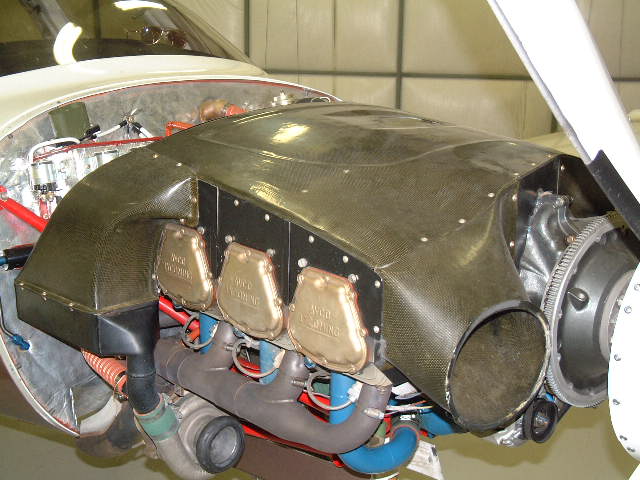|
|
Bob writes:
<<Bottom line, a nice plenum will get lots of oohs and ahhs, but probably won't cool your engine any better.>>
I (and NASA) would disagree with this statement in the general case. It is quite possible that Bob's implementation was significantly better than the original. Since I have not examined either one I have no reason to doubt the veracity of Bob's experience. I can counter with a few truths in the general case.
Air cooled aircraft engines are cooled by air MASS flow over the cooling fins. Mass flow is achieved by producing a pressure differential across the engine, between the upper plenum and the lower plenum. The "job" of the baffling is to expand the air path from the inlets to the engine to recover pressure, to direct the air uniformly through the engine and ancillary coolers, to collect the air after it passes through the engine and accelerate it out the discharges to free stream velocity or above. In theory this process can produce thrust due to the heat added by the engine. In theory, if you stand on a dock and spit into the ocean the sea level rises (but if you do this from a boat nothing happens). In practice, practical limitations result in a net cooling drag. The best we can hope for is to minimize this drag, which is a significant portion of total drag at the speeds where most Lancairs cruise.
The total air flow area available "through" the engine is surprisingly small. For a TIO-540 the flow area is equal to the area of a 3.45" diameter circle. Therefore the engine's airflow characteristics can be estimated by substituting the engine for a 3.45 inch diameter hole. A leak path around the engine with an area of 1 inch square (say 1/4" x 4") would represent 10% of the total airflow. According to a NASA study of typical GA engine installations, 50% of the cooling air bypasses the engine through leaks in the baffling. The majority of these leaks, the study concluded, were due to the poor sealing of the upper plenum as a result of using the silicone "gasket approach. Implementing a "doghouse" upper plenum significantly improved cooling efficiency. There is also a dynamic aspect to the sealing method which is that the engine is moving relative to the cowling so maintaining an air tight seal is problematic at best. I know several builders who have removed their cowlings after a high speed run to find their gaskets prolapsed.
Many early IVs had cooling problems and the general solution was to increase the discharge area to reduce the lower plenum's pressure, increasing the differential pressure across the engine and increasing air mass flow. The "Dolly Parton" lower cowl was born and now is standard. While effective, this method increases drag, which is never a good thing. If you have a boat with a hole in the hull you can prevent it from sinking by plugging the hole or running the bilge pump. Increasing the discharge area is like running the bilge pump. Effective but inefficient.
Another point many builders miss is that where there is air flow there is aerodynamics and where there is aerodynamics there is drag.
At the speeds we fly, airflow inside the cowling contributes significantly to total drag and there are measurable gains to be made by careful design of the cooling air flow paths.
I would offer the design of the plenum and baffling on N170BR as my attempt at improving engine cooling through efficient utilization of available airflow. Pictured below is the engine installation featuring carbon plenum intakes, cover and intercooler ducts. A sliding hatch allows access to the dipstick. It is interesting to note that this upper plenum cover weighs LESS than the 2" wide silicone gasket it replaces. I achieved a near net fit by using the upper cowling as a mold for the cover.
In practice I takeoff at 105% power, cruise climb at 90% power and cruise at 75% power. CHTs never get above 415 degrees F in climb and cruise CHTs are ~395 +- 5 degrees across ALL the cylinders, optimum for the Lycoming. I also have one of the original, small discharge, lower cowls. N170BR has demonstrated on several occasions that it is faster than the average IV. This picture was taken recently (~735 hours TTSN). The components have required very little maintenance. Upper spark plug access is achieved by removing 26 each #10 washer head screws and removing the cover which takes about 2 minutes using a power screwdriver.
While it is obviously possible to make a gasketed baffling system work, it is, IMHO, easier to achieve high levels of cooling efficiency using and enclosed upper plenum design. As we fly higher and faster cooling efficiency becomes more important and the benefits of good design more evident.
Regards
Brent Regan

N170BR-1.JPG
|
|